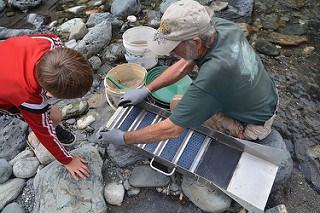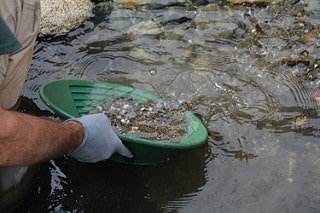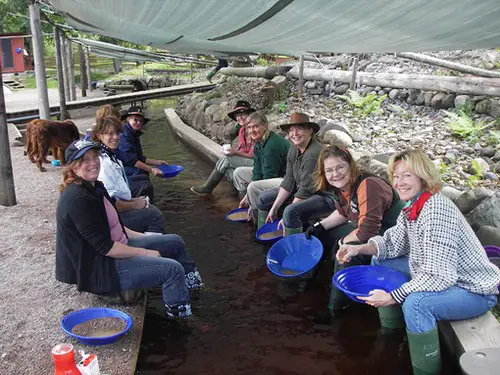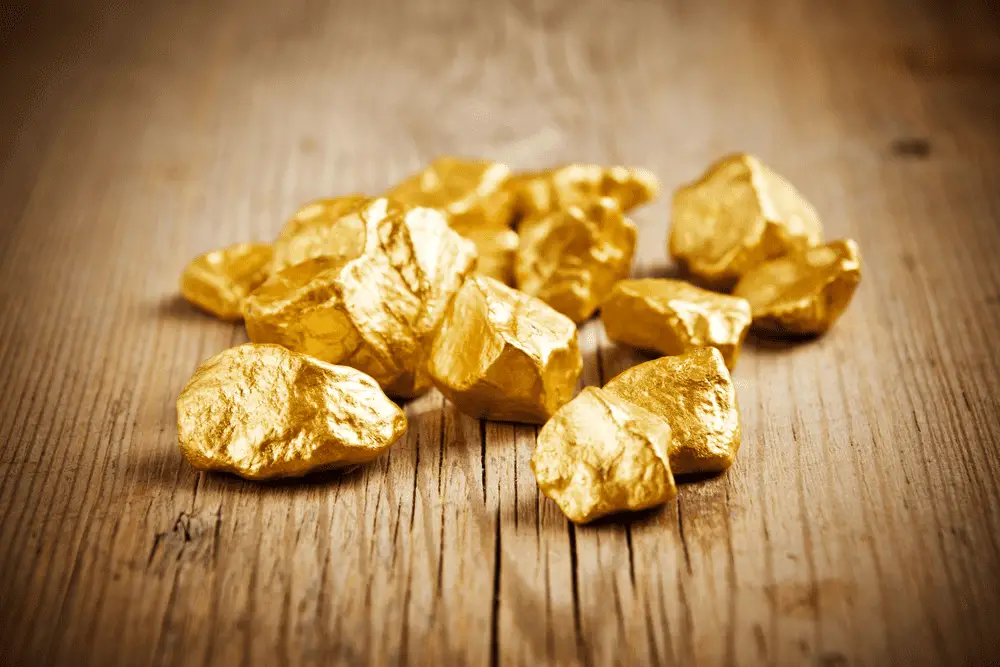Table of Contents
Do you often regret the fact that you were not alive in the 1840s and 50s to take part in the California Gold Rush? If so, you are in luck! Instead of waiting for the invention of the time machine why not try your hand at gold prospecting? It allows you to look for buried treasure in your free time; who didn’t grow up wanting to do that?
*This post may contain affiliate links. As an Amazon Associate we earn from qualifying purchases.
What Is Gold Prospecting?
Gold prospecting is the act of searching in the wilderness for new gold deposits. While this is often a commercial activity, completed by a team of prospectors with state-of-the-art machinery, it is also a popular hobby with amateurs. Looking for gold is like your own personal treasure hunt. In order to find the gold you are looking for, you will need strong research and investigation skills, much like a private eye trying to crack a case. The best part about looking for gold in your spare time is that you can actually make some money from your hobby. What other fun outdoor hobbies have the potential to make you money?

How to Prospect for Gold
Before you ever put your shovel in the ground, you will need to complete the required research. We will touch on just what needs to be investigated later on in this article. Once you have completed the required research and picked your first spot to start, you can begin panning for gold.
First Steps
After you fill your pan with the raw material you want to look through, you will dip the pan it into the water source. With both hands, you will then begin to filter through the material. This involves moving everything around, breaking apart dirt and sand and removing bigger pieces such as rocks or other debris.
Panning
Now you can begin swishing the leftover material back and forth. This is the panning part of the process. Continue removing larger material from the pan until all that you have left is fine sand and water. At this stage, you should be able to see flakes or nuggets of gold glistening. If there are none showing, simply add more material to your pan and start again. If you continue to come up empty-handed, you may want to consider changing your location.
Equipment
In addition to a gold panning pan, beginners can benefit from the use of a metal detector and pin-pointer. These devices help you identify a number of metals, including gold, and can help you determine if the spot you have chosen should be abandoned. Getting better at identifying metals can help you down the line when you are trying to figure out if what you found is really gold.
Why Should You Consider Gold Prospecting?
Gold panning is an outdoor hobby that can be enjoyed by anyone! It can also be done virtually anywhere. Simply carry your panning bucket, shovel, and metal detector with you next time you go on a camping or fishing trip and any outdoor activity can turn into a gold prospecting trip.
In addition to being a fun hobby, it is a great way to immerse yourself in history. Researching what areas looked like before highways and strip malls were built on them is essential to finding the right spot to pan.

How Do You Get Started Gold Prospecting?
All you need to do to get started gold prospecting is a desire to do so. As you get more involved and invested in the hunt for gold, you can purchase more expensive equipment that can help make you more successful. But when you are first starting out, just the basics will do fine.

Consider Joining a Club
If you are just getting started gold prospecting, you may want to consider joining a club. You can go with this group to areas they have already researched and claimed. After a few times out with the club, you will have built up your confidence to try going out on your own. In addition, you will receive the same benefit you do from joining any club – getting to spend time with people who share your interests. The new friends you can make at the outings will often share information and help you become a better prospector.
Do Your Research
In order to determine where to prospect for gold, you will need to do your research. You will need to determine where a creek or river once flowed and compare that to where it flows today. If there have been any active mining claims in that area or the new location is on private land, you will want to figure out a new location. In your research, you may discover that a stream had a diversion from where it used to flow. Exploring that area can typically be fruitful.
In addition to researching the history of waterways, you will learn the fundamentals of reading a flowing stream of water. Understanding the characteristics of a stream at low water versus high water is extremely useful. Being able to identify where a river flows at high water can tell you that a tangle of tree roots are usually covered by the river. Perfect sand for panning can become trapped in these roots; you would not know to look there unless you understood the water.
Since gold is denser than many other materials floating in the water, it typically floats to the bottom of a creek bed. With a shovel, you can dig up dirt and soil from around the creek. Understanding how the water flows can help you determine when you can gain access to the creek bed.
Understanding Gold Flake
Gold is dense, so when it settled it will find its way down through the sand and gravel and continue until it hits bedrock (there are other substances known as false bedrock where the gold may be sitting as well). When digging, if you hit the bedrock with too much force, from a shovel or pickaxe, it will crumble. Instead of trying to go through it, you should start digging sideways when you hit it. This will give you access to the mineral coating the bedrock, which is what you are after.
This is where you will find your gold flake. You can sweep up material found here to be panned later. You should also look for any cracks or crevices, which can collect gold.
In addition to understanding where to find the gold flake, you should also think of how you can use your time well. While being a professional gold panner would be great, you most likely have a day job and can only pan in your free time. So if you dig somewhere and pan the same day, you only have so much time you can spend out there. If you sample a bunch of different spots and make notes on which yielded gold flake, you can return and collect a bunch of material to bring home. Once home, you can do your final washing around your schedule.
It is important to note that this process is far less rewarding than digging and panning immediately, as you will not know how much gold flake you have found for some time. This method is recommended for more seasoned gold prospectors who have the goal of getting as much gold flake as possible.
Don’t Ignore Grass
While most gold prospectors stick to riverbeds, a small area of grass growing nearby should not be overlooked. The grass itself acts as sort of a sift, with the heavy gold falling to the roots of the grass. While the gold found here is often finer than flake (it is known as oat gold), when you find some you typically find a lot of it.
Always Sample
As mentioned before, sampling should not be overlooked. Sampling requires you to take a lot of – you guessed it – samples, of the area where you wish to pan. You will then take these gathered samples and pan them to determine if gold exists. You can then mark the spots where you were most successful and come back to them later.
Those experienced in gold prospecting will sample in several parts in one specific area. This way, they can determine where they find the most flake. By sampling a few parts, you will know where to best spend your time. Even if gold is found in all areas, there will be one spot with a higher concentration; this area is where you should start digging first.
Conclusion
As you can see, there really is no better way to experience the great outdoors while making a little bit of money on the side than gold prospecting and learning how to pan for gold. You will get to make new friends, explore areas you may otherwise have overlooked on your hikes through the woods and even get to learn more about the history of your region. If you have been considering gold prospecting, now’s the time to do it.

